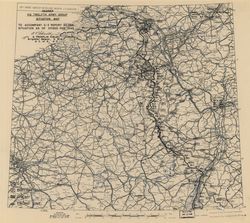 |
Lou Prucha WWII Service
|
 |
Viersen, Germany
(Communications Center)

Pilot's Flight Log |

12th Army Group Situation Map 24-Feb-1945 |
piloting 668 Bomb Sq. A-26B-25-DL Invader, Serial # 41-39325, Fuselage code 5H-L.
Click to display the official 416th Bomb Group Mission Folder, Mission Report and Operational Report
scanned to PDF files by the Air Force Historical Research Agency (AFHRA).
Group, Unit and Historical Extracts for Mission 213
"416th Bombardment Group (L) - Group History 1945"
Transcribed from USAF Archives
Another communications center on the Cologne Plain at Viersen was attacked on the 24th. Equipment in the PPF plane failed so the planes attacking with their own Gee equipment. On the last minute of the bomb run, the planes encountered moderate, accurate flak. Ten aircraft suffered battle damage. Results were unobserved through the clouds. Major Dunn, Lts Brewer and Maltby as B and N, and Lt Rooney, Lts Kirk and Koch as B and N, led the two boxes.
These two attacks were the beginning of a series of attacks made on targets on the Cologne Plain prior to and during the drive of the American First and Ninth Armies to the Rhine.
"Attack Bombers, We Need You! A History of the 416th Bomb Group"
Ralph Conte
Page 213
Mission #213 - 24 February - Vierson Communication Center. Major Dunn, Lts. Brewer and Maltby, BNs and Lts. Rooney with Kirk and Koch, BNs on Boxes. Captain Tutt and Lt. Beck, BN,- Lts. Lackovich and Muir, BN, -Captain Evans and Lt. McCartney, BN plus Lts. Anderson and Babbage, BN all led flights. The 416th and five other groups participated in the bombing to help advancing troops in close support for their advance toward Cologne. The 410th group bombed first with excellent results. Our group met a cloud cover, requiring GEE equipment bombing. Accurate flak bursts came up on the last minute of the bomb run, injuring ten aircraft. All planes returned safely to base.
"Operational History 668th Bomb Squadron (416th Bomb Group (L)) WWII"
Wayne Williams, et.al.
24th of February – our bombing today, continues to be in co-ordination with the Cologne bound U.S. Armies. We had twelve crews on the loading list for Group Mission # 213, with the two B/N Teams of Evans & McCartney, and Andersen & Babbage. Take off was in the early part of the afternoon; with the "Invaders" carrying loads of 250 lb. GP’s.
The communication center at Vierson was the target, and it was encased in low clouds as anticipated. The bombs were released from the altitudes of 11,500 feet and 12,500 feet employing "Gee" bombing technique. The results were of course "undetermined", as no photos were taken due to cloud cover. Weak inaccurate heavy flak, to heavy accurate flak greeted the formation, and although the flak damaged eleven of the planes, none were lost. The formation headed for home, and landed safely back at the base after three hours of flight. This was the only operational flying for the day.
"History of 670th Bombardment Squadron (L)"
Transcription from USAF Archives
Three more missions were flown on the 24th and 25th against communication centers at Vierson, Kerpen and Morvanich.
"671st Bomb Squadron (L) Unit History"
Gordon Russell and Jim Kerns
Continuing their close-in support for the Cologne-bound U.S.Armies the 9th Bomb Division, 416th included, struck heavy blows at rail and communication centers to halt the flow of enemy reinforcements to the Ninth Army Front. The 416th along with five other groups blasted the communication network and rail yard in the town of Viersen, 17 miles northwest of Dusseldorf. The 410th Group bombed first and obtained excellent results on visual bombing. However, the weather closed in over the target a few minutes later and results of the other outfits were unobserved.
The 416th bombed by boxes on the group lead using Gee. Eleven aircraft received battle damage, but all the ships and crews returned safely.
"USAAF Chronology of WWII, month by month"
TACTICAL OPERATIONS (Ninth Air Force): In Germany, nearly 500 B-26s, A-20s and A-26s hit 5 communications centers, 2 marshalling yards, 3 rail bridges, 6 town areas, and a target of opportunity as part of interdiction operations against troops during the Rhineland campaign; fighters support the 8th and 104th Infantry Divisions in the Duren area, the XIII and XIX Corps at the Roer River bridgehead area, and the VIII, XII, and XX Corps E of and along the Prum River and in the Saarlautern area.